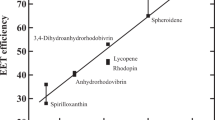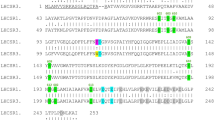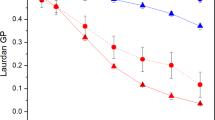Abstract
A RELATION between photosensitivity and the loss of carotenoid pigments has been observed in Rhodopseudomonas 1, Chlorella 2, Chromatium 3, Chlamydomonas 4, Rhodospirillum 5, Corynebacterium 6 and Zea mays 7. Sistrom et al. have suggested that photosensitization in the carotenoidless mutant of Rhodopseudomonas spheroides ‘… is a specific consequence of the replacement of carotenoid pigments with a colourless polyene.’ and that ‘… the primary function of carotenoid pigments in phototrophs is to act as chemical buffers against photo-oxidation of other cell constituents by chlorophyll, thus conferring a high degree of immunity to endogenous photosensitization.’8 The carotenoid may carry out this buffering function by acting as a preferentially photo-oxidizable substrate. The effectiveness of such a photochemical buffering system would depend on the existence of an enzymatic mechanism which could reduce the photo-oxidized carotenoid. Inhibition of this enzymatic reduction should result in photosensitization. Accordingly, the effect of low temperature on the photosensitivity of wild type R. spheroides (2.4.1) and Rhodospirillum rubrum was investigated.
This is a preview of subscription content, access via your institution
Access options
Subscribe to this journal
Receive 51 print issues and online access
$199.00 per year
only $3.90 per issue
Buy this article
- Purchase on Springer Link
- Instant access to full article PDF
Prices may be subject to local taxes which are calculated during checkout
Similar content being viewed by others
References
Griffiths, M., Sistrom, W. R., Cohen-Bazire, G., and Stanier, R. Y., Nature, 176, 1211 (1955).
Claees, H., Naturforsch., 9, b, 461 (1954).
Fuller, R. C., and Anderson, I. C., Nature, 181 (1958).
Sager, R., and Zalokar, M., Nature, 182, 98 (1958).
Cohen-Bazire, G., and Stanier, R. Y., Nature, 181, 250 (1958).
Kunisawa, R., and Stanier, R. Y., Archiv Mikrobiol., 31, 146 (1958).
Koski, V. M., and Smith, J. H. C., Arch. Bioch. Biophys., 34, 189 (1951).
Sistrom, W. R., Griffiths, M., and Stanier, R. Y., J. Cell. Comp. Physiol., 48, 459 (1956).
Cohen-Bazire, G., Sistrom, W. R., and Stanier, R. Y., J. Cell. Comp. Physiol., 49, 25 (1957).
Dworkin, M., J. Gen. Physiol., 41, 1099 (1958).
Author information
Authors and Affiliations
Rights and permissions
About this article
Cite this article
DWORKIN, M. Function of Carotenoids in Photosynthetic Bacteria. Nature 184, 1891–1892 (1959). https://doi.org/10.1038/1841891b0
Issue Date:
DOI: https://doi.org/10.1038/1841891b0
Comments
By submitting a comment you agree to abide by our Terms and Community Guidelines. If you find something abusive or that does not comply with our terms or guidelines please flag it as inappropriate.



